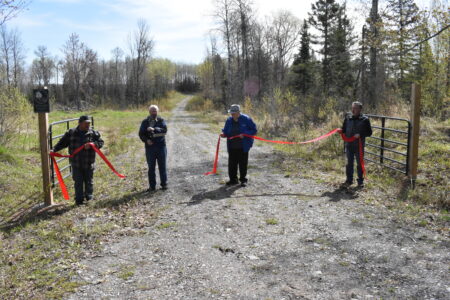Taking preventative measures in Ripley: Rerouting stormwater, adjusting rail grades
RIPLEY — After flash flooding on June 17 and then again on July 12, steps are being taken to prevent significant damage from happening again.
So far efforts have focused on clearing culverts, stopping further erosion and reworking old rail grade. Some of that work was tested by the July 12 flooding.
After the first flood, it was all hands on deck with opening the now rock- and sediment-filled Ripley storm sewer and preparing for more rain, said Steve Casey, project lead for the Department of Environmental Quality (DEQ)
“We met with Michigan Tech and they agreed to a program to make sure material didn’t slump off the ski hill anymore,” Casey said. “They rerouted the storm water in a very secure manner to make sure that, even in a big storm, that would never happen again and they did a temporary stabilization.”
Long-term stabilization is planned before the snow flies this year.
Notably, the day before the July 12 flooding the 100-foot-high grade on Quincy Hill above Ripley was disassembled. The grade had partially failed in the first rain and was constructed mainly of large “watermelon-sized or bigger” rocks.
“Some of it had already sloughed off and was down in the creek. The culvert was exposed and breaking apart, it almost certainly would have plugged and then that tremendous flow of water would have knocked it down and sent it down that very steep hill into town,” Casey said.
He suspects if not for its removal the resulting damage would have been even worse than the initial flooding that destabilized it due to the size of the materials.
“Thank god the storm came a day after and not a day before we got that out of there,” he said.
Instead of causing damage, some of the rock is being used to stabilize a site in Lake Linden and other locations.
At the Department of Natural Resources (DNR), there is a different approach to old rail grade for areas being used as trail, explained Jeff Kakuk, western Upper Peninsula trails specialist. When railbank culverts are replaced part of the grade is removed in a method called a broad-based dip.
“It just allows the water to flow over if something gets blocked. That is a common practice now, we do that in every situation where we can,” Kakuk said.
Flooding put the design change to the test with at least one major success story. A 100-foot high grade north of Lake Linden failed but the materials and water flushed through and over the 36-inch culvert keeping that grade stable.
“You can only do so much, he said. “Mother Nature can be extreme but we’ll look at every option we can.”
Right now the DEQ is working to ensure the remaining rail grades and culverts are unplugged with a little bit of cleanup mixed in.
The culverts are being examined individually but in general bigger culvert replacements are being required, Casey explained.
Teams of eight to 12 people are currently at work daily with multiple agencies involved.
“We’ll be here as long as we have money to be here,” Casey said.
The DEQ is currently looking at six to eight weeks of available funding.




